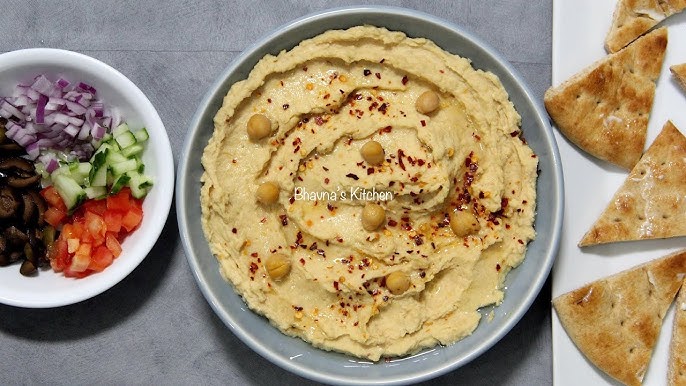Hummus Recipe: Hummus is a creamy, flavorful dip or spread made primarily from chickpeas, tahini (sesame seed paste), olive oil, lemon juice, and garlic. It’s a popular Middle Eastern dish that has gained worldwide fame due to its delicious taste, versatility, and health benefits. Whether you’re enjoying it as a dip with pita bread or using it as a spread on sandwiches, hummus is a must-have in any kitchen.
But what makes hummus so special? Why has this simple dish become such a beloved staple across cultures? Let’s dive into the fascinating world of hummus and learn how to make it from scratch!
Health Benefits of Hummus
Hummus isn’t just a tasty treat—it’s also packed with nutrients that make it a healthy choice for almost any diet.
Nutritional Profile of Hummus
One of the reasons people love hummus is its incredible nutritional value. It’s rich in plant-based protein, making it an excellent option for vegetarians and vegans. Chickpeas are full of fiber, which helps with digestion and can aid in maintaining a healthy weight.
Rich Source of Plant-based Protein
For those looking to add more protein to their diet without relying on meat, hummus is a great option. One serving of hummus provides about 2-3 grams of protein, which helps build and repair tissues.
Healthy Fats and Fiber Content
Thanks to olive oil and tahini, hummus is also a source of healthy fats. These fats help lower bad cholesterol levels, supporting heart health. Additionally, chickpeas are high in fiber, promoting good digestion and keeping you feeling full longer.
Key Ingredients for Hummus
To make hummus, you only need a few simple ingredients. Each one plays a crucial role in creating the delicious flavor and smooth texture of the dish.
Chickpeas (Garbanzo Beans)
Chickpeas are the star of the show. You can use canned chickpeas for convenience or dried chickpeas for a more authentic, rich flavor.
Tahini (Sesame Seed Paste)
Tahini adds a nutty, slightly bitter flavor that balances the creaminess of the chickpeas. It’s a crucial ingredient for authentic hummus.
Lemon Juice
Freshly squeezed lemon juice adds brightness and a tangy zest that cuts through the richness of the other ingredients.
Garlic
A small amount of raw garlic gives hummus its signature bite. You can adjust the garlic amount depending on how strong you like the flavor.
Olive Oil
High-quality extra virgin olive oil makes the hummus smooth and adds a subtle fruity flavor.
Salt and Spices
A pinch of salt enhances the overall flavor, while spices like cumin or paprika add depth and warmth to the dish.
Types of Hummus
While the classic version is always a hit, hummus can be adapted to suit various flavor profiles. Here are a few popular variations:
Traditional Hummus
The original, creamy hummus made with just chickpeas, tahini, lemon juice, garlic, and olive oil.
Roasted Red Pepper Hummus
Adding roasted red peppers creates a smoky, sweet flavor, perfect for those who want a twist on the classic.
Beetroot Hummus
For a vibrant pink color and a slightly earthy taste, blend roasted beets into your hummus.
Spicy Hummus
If you like some heat, add a dash of cayenne pepper or blend in some chili for a spicy kick.
Step-by-Step Guide to Making Hummus
Now, let’s get to the heart of the matter—making delicious hummus from scratch. Follow this step-by-step guide to create the perfect batch every time.
1. Preparing the Chickpeas
You can either use canned chickpeas (quick and easy) or cook dried chickpeas from scratch for a richer taste. If you choose dried chickpeas, soak them overnight and cook them until they’re soft.
2. Blending the Ingredients
In a food processor, combine the chickpeas, tahini, lemon juice, garlic, and a little salt. Pulse until the mixture starts to come together.
3. Adding Tahini, Garlic, and Lemon Juice
The balance of tahini, garlic, and lemon juice is key. Start with small amounts, taste, and adjust to your liking.
4. Adding Olive Oil for Creaminess
While the processor is running, slowly drizzle in olive oil. This helps to make the hummus smooth and creamy.
5. Adjusting Texture
If the hummus is too thick, add ice-cold water (a tablespoon at a time) until you get the perfect smooth texture.
6. Seasoning the Hummus
Add salt to taste and, if you like, a pinch of cumin or smoked paprika for extra flavor.
Garnishing Hummus
Once your hummus is done, transfer it to a serving bowl. Make a small well in the center and drizzle some olive oil on top. You can also sprinkle it with paprika, cumin, or fresh herbs like parsley for added visual appeal.
How to Serve Hummus
Hummus is incredibly versatile. Here are a few ways to serve it:
Best Dishes to Serve with Hummus
Hummus pairs well with fresh vegetables like cucumber, carrots, and celery. It’s also fantastic with pita bread or crackers.
Hummus as a Dip
Serve it as a dip at parties, alongside vegetable sticks, pita chips, or tortilla chips.
Hummus as a Spread
Use hummus as a spread on sandwiches, wraps, or even burgers for an extra layer of flavor.
Tips for Perfect Hummus Every Time
- Use High-Quality Tahini: Not all tahini is created equal. Opt for smooth, high-quality tahini for the best results.
- Ice Cold Water for Smoothness: Adding cold water during blending creates an extra-smooth and fluffy texture.
- How to Avoid Grainy Texture: Make sure your chickpeas are cooked thoroughly. Overcooked chickpeas are better than undercooked ones.
Storing and Freezing Hummus
How Long Can You Keep Hummus in the Fridge?
Store homemade hummus in an airtight container in the fridge for up to one week.
Tips for Freezing Hummus
Hummus freezes well! Place it in a freezer-safe container, leaving some room for expansion, and freeze for up to three months. Thaw it in the fridge overnight before serving.
FAQs about Hummus Recipe
1. What ingredients do I need for a basic hummus recipe?
To make basic hummus, you will need chickpeas, tahini (sesame paste), lemon juice, garlic, olive oil, and salt. Some recipes also suggest adding a bit of cumin or paprika for extra flavor.
2. Can I make hummus without tahini?
Yes, you can make hummus without tahini by substituting it with another nut or seed butter, such as almond butter. However, tahini is traditionally used for its unique flavor.
3. How long does homemade hummus last?
Homemade hummus can be stored in the refrigerator in an airtight container for up to five days. Ensure it’s covered properly to maintain freshness.
4. Is hummus healthy?
Hummus is generally considered a healthy food as it contains a good balance of protein, healthy fats, and fiber. It’s also a good source of vitamins and minerals like iron and folate.
5. What can I serve with hummus?
Hummus is versatile and can be served with a variety of dishes. Popular pairings include raw vegetables, pita bread, crackers, or as a spread in sandwiches and wraps.
6. Can I freeze hummus?
Yes, you can freeze hummus for up to four months. To use, thaw it in the refrigerator overnight and give it a good stir before serving, as it may separate slightly.
7. How can I make my hummus creamier?
For creamier hummus, blend the chickpeas while they are still warm, and consider adding a bit more tahini or olive oil. Some people also suggest peeling the chickpeas to remove any skins that might create a gritty texture.
Conclusion
Hummus is a simple, healthy, and delicious dish that you can easily make at home. Whether you’re making the traditional version or experimenting with new flavors, this step-by-step guide will help you create hummus that’s smooth, creamy, and full of flavor. Once you master the basics, feel free to get creative with spices, herbs, and add-ins to customize your hummus to your taste!



